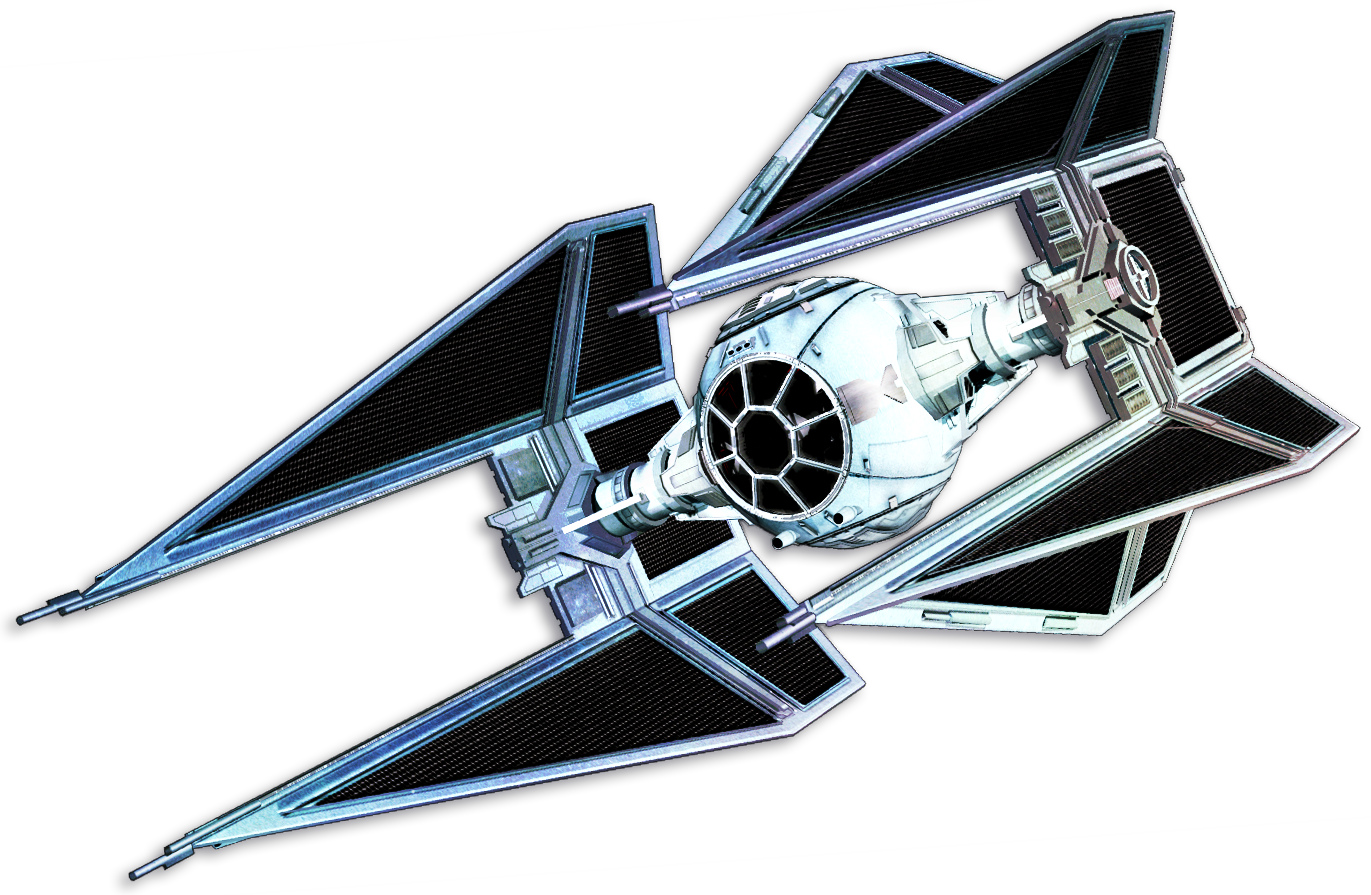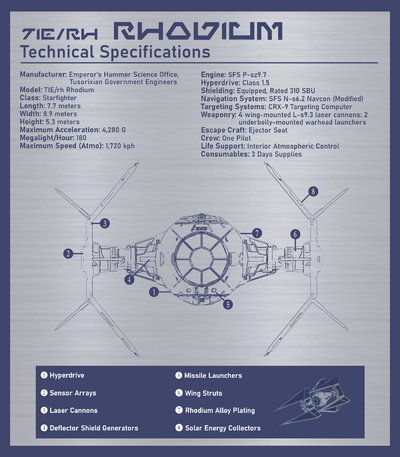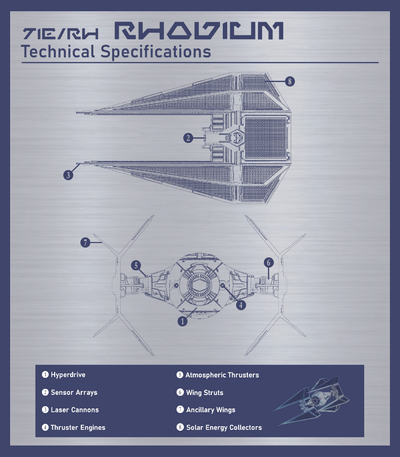TIE Rhodium

| |
| TIE/rh Rhodium | |
| Production Information | |
| Manufacturer: |
EH Science Office & Tusorix Government Engineers |
| Product Line: |
TIE Series |
| Model: |
Modified TIE Interceptor |
| Class: |
Interceptor |
| Technical Specifications | |
| Length: |
7.7 m |
| Width: |
8.9 m |
| Height & Depth: |
4.8 m |
| Engine Units: |
SFS P-sz9.7 Twin Ion Engines |
| Hyperdrive Rating: |
Class 1.5 |
| Power Output: |
180 MGLT |
| Armaments: |
SFS L-s9.3 Laser Cannons (4) |
| Crew: |
1 |
| Passengers: |
0 |
| Fleet Information | |
| Affiliation: | |
| [ Source ] | |
The TIE/rh Rhodium is a modified version of the TIE/IN Interceptor that was specially created for Rho Squadron. With a hull plated in a custom alloy of quadanium steel and rhodium, a rare metal found on the second moon of Tusorix, the TIE Rhodium has several unique characteristics that make it one of the deadliest craft in the Emperor's Hammer fleet. During its service history, Rho Squadron has been the only user of the Rhodium, with only twelve such craft being built. The ship was jointly designed by the Emperor's Hammer Science Office and Tusorix Government Engineers, with six Rho Squadron pilots serving as consultants: Alexandre Morgan, Westric Davalorn, fr0Zen, Isabis Kamaria, Maston Dane, and Ispep.
Development
The TIE/rh Rhodium is a product of a collaboration of the Emperor's Hammer Science Office and Tusorixian engineers. When deposits of the rare metal were found on the mining moon, the government of Tusorix found it fitting to gift a large portion of their spoils to the Emperor's Hammer in thanks for their defense of the planet against the Ishtari in 29 ABY.
In addition to the gift, Tusorixian scientists recommended that a new craft be designed, using the material as hull armor, parts of ship components and modules, and more, which would give the craft unique characteristics and abilities. In cooperation with the EH Science Office, a alloy was created of the rhodium and quadanium steel that preserved each's respective characteristics, with little sacrifice of either the strength of the quadanium and abilities of the rhodium.
Already having selected Rho Squadron to fly the craft, the Science Office and Tusorixians created, using inspiration from both past Imperial ships and Tusorixian sailing heritage, an interceptor craft dubbed the TIE/rh Rhodium.
Characteristics
Hull
The TIE/rh Rhodium’s hull is plated in an alloy of rhodium metal and quadanium steel. Quadanium is the typical metal used in TIE construction. Rhodium is a rare metal with a vast array of properties and characteristics, including:
- Alloys with other metals without detriment to characteristics
- Strong, resisting physical damage
- Special molecular lattice that dissipates energy
- High heat resistance
The unique traits of rhodium allow for multiple abilities and characteristics that, when alloyed with quadanium, alter the behavior and capabilities of the TIE/rh. Some of these include:
1. The craft can disperse ionization and laser cannon energy, taking less damage. Due to the energy dispersion characteristic of rhodium, the ship is entirely unable to be impaired by ion lasers, scattering the constituent ions through the unique molecular lattice and rendering the effects negligible. This allows for easier assaults on craft with ion weaponry and prevents the TIE/rh from being disabled. This energy dispersion also affects laser cannon energy to a lesser effect. Partial amounts of the laser energy are scattered through the lattice, specifically the ion elements, somewhat lessening the damage inflicted and increasing the ship’s survivability.
2. The craft has a much stronger hull plating. Because of the rhodium alloy, the ship’s hull has significantly increased durability and is capable of withstanding greater laser and missile damage than a comparable vessel. The hull is rated an astounding 32 RU due to this breakthrough rhodium alloy, thus allowing pilots to focus more energy management to strike patterns than defensive patterns, and restore the system balance during retreat maneuvers.
3. The craft suffers less heat-related impairments to both hull and modules. The rhodium alloy has been used in both the hull and the heat-sensitive modules of the TIE/rh. As rhodium is an exquisitely efficient heat-resistant insulator, the craft can fly closer to sources of heat without worry. Examples include nebulae, stars, and planetary re-entry. In addition, the fighter’s weapon systems, twin ion engines, and other systems also suffer less heat-related wear and tear which allows for increased thruster performance, boosted thruster output and speed, and increased firing duration of the laser cannons.
4. The rhodium alloy adds no mass to the ship. Normally, a stronger metal plating on the chassis of a craft would increase mass dramatically, which could be detrimental to an interceptor-styled craft. Thanks to precision engineering, the rhodium and quadanium alloy has been crafted to be consistent with the payload of the average TIE craft.
Chassis Structure
The custom chassis of the TIE/rh is inspired by Tusorixian origins. When compared to its closest visual relative, the TIE/IN Interceptor, the craft sports four extra wings. This modification provides a massive amount of solar-collecting area which is critical to the performance of the TIE/rh. The extra solar-collection wings supply additional power for a shield generator, boosted thrusters, and increased laser performance, as well as a navigational computer subroutine to monitor the flight plan and hyperspace adjustments relative to the current orientation. These ancillary wings, borne of the traditional Tusorizian designs, also contribute to heightened in-atmosphere maneuvering stability, allowing for tighter roll maneuvers, a higher opportunity for firing solutions, and less overall time with the craft's flanks exposed.
Role
The TIE/rh’s unique rhodium-based characteristics allow for increased hull strength and superb heat and energy dissipation, leading to the craft’s improved durability, resistance to energy weapons, ion neutralization, increased firing duration, and superior thruster performance. These features give the craft a remarkable edge in combat situations. Moreover, the heat-dissipating properties of the alloy permit the TIE/rh to increase its tolerance for a broader range of engagement scenarios, from interstellar radiation sources to atmospheric entry and escape friction.
The chassis design and additional solar energy collection allow the craft to achieve a standard of performance that is unrivaled. This affords the TIE/rh maneuverability, reaction time, and power management that outperforms any standard issue ship. Likewise, the custom navigation computer’s realtime hyperlane computations equip the TIE/rh with the fastest theater of operation extraction times available in a fighter craft.
A pilot with mastery of the TIE/rh Rhodium can wield the ship’s unique abilities to become near-unstoppable in dogfights as well as pose a formidable threat against larger ships.
Technical Specifications
Current Usage
Since the Rhodium was designed for specifically Rho Squadron, not many of the craft were produced. The only examples of the craft that are currently able to be seen in active duty for the Emperor's Hammer belong to the pilots of Rho Squadron. Each of them (with the exception of one, who flies his namesake craft) prizes their unique fighters. Some have even decided to proudly given them appropriate names further than their squadron identification number to showcase their own personal ethos and thoughts about their Rhodium craft. You can view these names in the chart below, updated to reflect the current Rho Squadron composition.
| Rho Squadron | Pilot Name | Ship Name |
|---|---|---|
| 1 | Maston Dane | Nemesis |
| 2 | Vanguard88 | It Me (T/V Vanguard) |
| 3 | Ispep | Rho 3 |
| 4 | Alexamdv Corachan | Rho 4 |
| 5 | Alexandre Morgan | Skira Naasad |
| 6 | Jaquel Rainrix | Skystalker |
| 7 | FamePlane | Rho 7 |
| 8 | Miguel | Rho 8 |
| 9 | Isabis Kamaria | Rho 9 |
| 10 | OL"Davy Jonez | DUTCH RUDDER |
| 11 | Westric Davalorn | Talon |
| 12 | Rotarg Kradak | Rho 12 |
In addition, there are several other TIE/rh Rhodium craft besides these of Rho Squadron. Former Rho Squadron pilot and member Fr0Zen was a member of Rho Squadron when it earned and recieved these special craft, and upon his promotion to Battlegroup Commander was allowed to retain its usage. His personal craft, the TIE/rh Di'Jai, sees less usage currently due to its pilot serving as BGCOMM, but it still stands as a hallmark and indicator of the potential of Rho Squadron pilots and the prowess of the Emperor's Hammer Science Office and engineers.
As not all of the metal was used in the production of the twelve initial craft, however, some remains. A portion of the special Rhodium metal and alloy were retained in natural form to be used as repairs and patches for the existing craft, but it is also known that some of the excess was forged into extra Rhodium craft. It is unknown how many of these extra craft exist, but it is assumed to be from two to five extra, using metal quantity and usage estimates.

